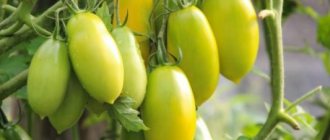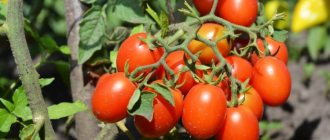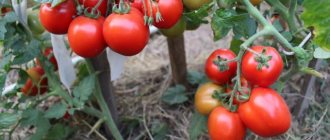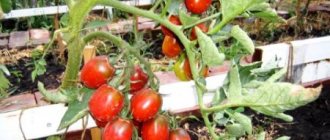Vegetable growing » Tomatoes
1
1956
Article rating
Kira Stoletova
Russian breeders have developed a hybrid tomato variety, Gina TST. The fruits of this variety are large and have excellent taste. The Gina TST tomato has a high yield and is characterized by early ripening. This sets it apart from other varieties.
Description of Gina TST tomatoes
The description of the variety says that the use of the Gina tomato is limited. They are not suitable for pickling. It is recommended to consume the fruits fresh, in salads.
Description of tomato Gina TST
The Gina TST tomato, the characteristics and reviews of which are given in the article, is recommended for cultivation in all climatic zones of the Russian Federation. It is suitable for cultivation both in open ground and in greenhouses and greenhouses.
If you believe the reviews of those who planted the Gina TST tomato and the photos they presented, the main difference between the variety is the shape of the plant. However, experts also say that it is classified as determinant or limited in growth. Its height is 50-65 cm. It grows in the form of a small but powerful bush. Immediately 3-4 thick, densely leafy shoots emerge from the root.
Attention! Many gardeners confuse this variety with a variety with a similar name. However, Gina is a variety that differs significantly from D. TST in the size and color of the fruit. Although both varieties are low-growing and quite productive.
The leaves of the tomato are medium-sized or slightly larger. The leaf blades are dense, fleshy in appearance, with a slightly noticeable drooping. The color of the tops is rich, dark green. In the photo of a blooming tomato by Gene TST, it can be seen that it forms simple inflorescences of light yellow color, collected in brushes of 3-5 pieces.
The fruits of the Gina TST tomato are classic tomatoes, which is confirmed by reviews and photos taken by vegetable growers. Large, almost regular round shape, with slightly pronounced ribbing at the stalk. The average fruit weight is 200-280 grams. But real heroes weighing 400 grams are far from uncommon.
The color of a tomato at the stage of technical maturity is orange-red or red with thin blurred stripes of a yellow tint. Upon reaching biological maturity, they become bright red and very appetizing in appearance.
When describing the taste qualities of Gina TST tomatoes, they note a balanced taste, high sugar content, meatiness and juiciness. The skin of tomatoes is dense. The pulp of tomatoes is fleshy, somewhat loose. Sugar content appears on the cut. At the same time, tomatoes are juicy due to the formation of 6-8 chambers filled with juice and a small amount of small seeds.
Description and characteristics of the variety
The Dutch tomato variety Gina was included in the State Register of the Russian Federation in 2000. The tomatoes are intended for growing in greenhouses, as well as in areas with an initial film cover.
- Variety, not hybrid.
- Mid-season. The fruits ripen 110-120 days after seed germination.
- Determinate with limited stem growth, not standard. The bush grows up to 50-60 cm in height. It consists of three main stems that grow from the very root.
- Suitable for cultivation in the south of Russia, Moldova and Ukraine. Here it is grown in open ground, without covering with film. For colder climates, tomatoes need greenhouse conditions.
- Medium-leafed bush with large green leaves.
- During the growth period, gartering, pinching and bush formation are not required.
- The inflorescences are simple. The first is formed over the 8-9th leaf, the next ones over every 3rd leaf. From 3 to 6 tomatoes are formed on one brush.
- The variety does not tolerate sudden changes in temperature, so if necessary, young seedlings in open ground are covered with film.
- Resistant to diseases such as late blight, mosaic virus, verticillium, root rot and fusarium. May be attacked by pests.
- High yield. If all growing rules are followed (watering, fertilizers), 1 bush can produce up to 4 kg of large tomatoes.
- There is also a hybrid form of this variety: Gina TST. The hybrid was later developed by specialists from Moscow agro.
Characteristics of tomato Gina TST
Gina TST, like other tomato varieties, is not frost-resistant. Even at zero temperatures, the leaves turn black and wither. With small lesions, tomatoes produce new shoots, but the yield decreases. However, the Gina TST tomato develops well in cool weather without forming empty flowers. It cannot be called drought-resistant, but the variety also does not like waterlogging.
The tomato is a mid-season variety with an average fruiting period. It enters the technical maturity stage 100-110 days after emergence.
Typically, such tomatoes are removed for further storage and transportation. But Gina TST has a thick skin. They ripen well on the branches. Its fruits are not prone to cracking during transportation and storage. It is for these characteristics and excellent taste that farmers love the variety.
The yield of Gina TST tomato declared by Agro LLC is 6-10 kg/m². But many vegetable growers claim that it is much higher. In conditions of good lighting and a lot of warm days, you can collect up to 20 kg/m². Of course, if you don’t neglect fertilizing and watering.
Watering a tomato
Irrigation of Gina tomatoes has its own characteristics:
- increased hydration leads to a decrease in the sugar content of the fruit and the appearance of a watery structure. The risk of fungal diseases increases;
- Prolonged drought can cause tomato ovaries to fall off and plants to become infected with blossom end rot.
Therefore, infrequent but abundant watering can be considered the golden mean. The best option: once or twice a week. When choosing an irrigation regime, it is important to take into account the climatic characteristics of the region. Be careful not to get moisture on the stems, leaves and fruits. On hot sunny days, it is advisable to set aside evening time for watering the Gina tomato, but in cloudy weather, watering time is not particularly important.
Important! The frequency and rates of watering tomatoes are increased during the formation of ovaries and during the fruiting period.
General care for Gina is simple: weed the soil, loosen the soil after watering. When loosening the bushes, care must be taken not to damage the root system of the tomatoes. The tomato does not need a mandatory garter. This will most likely be the whim of the gardener. It is recommended to hill up the plant.
There is no need for pinching tomatoes. The bush is usually formed from 3-4 stems. Moreover, it is recommended to carefully tear off the lower leaves in order to increase plant ventilation. The leaves must be cut carefully so as not to damage the skin of the trunk.
The Gina tomato is a very productive variety. With proper care, each bush produces 3-4 kg of excellent, mouth-watering tomatoes.
Planting and caring for tomatoes Gina TST
The Gina TST tomato is grown in seedlings in the climatic conditions of the middle zone. Only in the southern regions is it possible to plant seeds in the ground.
They begin sowing seeds for seedlings in the second half of March. If you plan to grow Gina TST in a greenhouse, then work begins in the middle of the month. Otherwise, you should wait a couple of weeks.
Attention! Many vegetable growers are misled by the abbreviation TST and consider the variety to be a hybrid. This is wrong. Therefore, you can safely collect Gina TST tomato seeds yourself. Just don’t forget to treat them with any antifungal drug before sowing.
Sowing is carried out in containers tightly filled with soil. It can be bought at the store or prepared at home. To do this, just mix garden soil, humus and peat in equal proportions. Many people use coconut fiber as a leavening agent instead of peat.
Gina TST tomato seeds are laid on the surface, leaving a distance of 2-3 cm between them. Mulch on top with a layer of prepared soil about 1 cm high. Moisten generously with a spray bottle, cover with glass or film and place in a warm place for germination. Shoots appear on days 5-7.
Subsequently, seedlings:
- transferred to a well-lit place;
- water in a timely manner;
- at the stage of 2-4 true leaves, pick up in separate pots;
- Before transplantation, 3 fertilizing with mineral fertilizers is carried out.
Gina TST tomatoes are planted in the greenhouse in the first half of May. In open ground towards the end of the month, when the threat of night frosts has passed. You can plant it earlier if the soil has time to warm up to 10-12 degrees Celsius, and provide temporary shelter.
Brief information about the hybrid
- Fruits and bush: determinate plant, bush height up to 0.65 m, fruits weighing 200 g.
- Productivity: up to 12-16 kg/1 m².
- Resistance: relative resistance to fusarium and verticellosis, does not tolerate short-term temperature drops.
- Application: mainly for fresh consumption or preparation of first and second courses, of little use for preservation.
- Planting: Suitable for open and closed conditions, seedling planting is preferred.
- Soil: loose, nutritious, neutral acidity.
- Care: classic, does not require pinching, weak-growing stems are not brittle, but due to the large fruits and strong growth, tendency to spread on the ground, gartering is recommended, feeding up to 4 times during the growing season with an interval of 2 weeks.
- Ripening period: 100-105 days after emergence.
Diseases and pests
According to the descriptions of the variety, the Gina TST tomato is resistant to verticillium wilt and fusarium. Relatively resistant to late blight. To avoid tomato diseases, preventive measures are taken, namely watering at the roots, regular ventilation of greenhouses, and spraying plants with antifungal drugs.
Tomatoes are rarely affected by pests. The most common of them are spider mites and aphids. When they are detected, the bushes are treated with chemicals or folk remedies.
Tomatoes: sowing seeds for seedlings (video)
- Young seedlings should be picked at the stage of formation of two true leaves;
- Optimal temperature conditions and lighting should be maintained for the growth and development of vegetable crops, which will prevent the seedlings from stretching and make them of the highest quality;
- watering is carried out as needed, with warm and settled water;
- if the seedlings are stunted in growth, it is recommended to carry out two feedings with special complex fertilizers;
- Before planting in a permanent place, tomato seedlings are hardened on the street or balcony.
You can plant tomato seedlings in a permanent place under a film cover already in the middle of the last spring month. Seedlings are planted on open ground ridges no earlier than June. High-quality tomato seedlings at the age of two months should be strong and have approximately five to seven true leaves. The standard planting pattern is 50x40 cm with a density of 7-9 plants per square meter of planting area.
Reviews of the tomato variety Gina TST
Maria, 40 years old, Ryazan I love Tomato Gina TST for his short stature. Much easier to care for. Many people prefer higher grades. They say their productivity is higher. Not true. The harvest is quite high. The only drawback is that the stems break under the weight of the fruit.
Olga, 48 years old, Serpukhov I grow tomatoes in open beds. Gina TST has never failed. Cold or hot, I always have a harvest of excellent tomatoes. The kids really like the tasty and sweet ones. It's a shame they don't fit into the jar. It won't be possible to roll it up.
Features of care
Caring for Gina tomatoes involves timely watering, fertilizing (if necessary) and pest control.
The variety does not require shaping, and gartering is done if necessary. In the southern regions, gardeners do not tie up bushes. When the branches bend to the ground under the weight of the fruit, they thereby prevent the root system from drying out.
Watering
Most tomatoes, including Gina, react to excessive watering by losing their sugar content, and the flesh becomes watery. Lack of moisture is also destructive - the ovaries fall off without gaining volume. Therefore, watering should not be frequent, but plentiful. Water tomatoes in the evening or early in the morning.
Fertilizers and fertilizers
If the soil is poor in microelements, Gina tomatoes should be fed after planting in the ground. If a good amount of compost was added to the soil in the fall, then fertilizers do not need to be applied.
The first feeding is carried out 1.5-2 weeks after planting. Any complex mineral fertilizer is suitable. Before fruit set, you can alternate root and foliar fertilizers. After the ovaries have appeared - only root treatment.
Also, after planting, 5-10 days later, it is advisable to treat the foliage and stems with boron and calcium-based fertilizer. Boron improves flowering, and calcium prevents blossom end rot.
Harvesting
The fruits do not ripen at the same time. Therefore, fruiting is long and lasts until the beginning of autumn.
When ripening, tomatoes do not lose their taste. Once picked, they can be stored for up to 3 months, remaining juicy.
Feeding with fertilizers
Tomato Gina: photo of variety
When planting seedlings in the ground, we recommend sprinkling ordinary ash at the bottom of the hole; it will become a source of microelements and will also provide preventive protection for tomatoes against certain types of diseases. With the seedless growing method, the plant is fed immediately after thinning the seedlings; for this, 15 grams of ammonium nitrate must be diluted in 10 liters of water. One hole requires a liter of solution. When planting seedlings, fertilizing with fertilizers is carried out after two weeks. For subsequent fertilizing, mineral fertilizers are used. In the absence of inorganic fertilizers, you can use organic ones; for this, one liter of manure is diluted in 10 liters of water and infused for about 10-12 days. After this, one liter of manure infusion is diluted in 10 liters of water. One liter of solution should be poured under each bush. The best periods for feeding are the stage of ovary formation and the stage of fruit ripening. It is necessary to alternate the application of root and foliar fertilizers to obtain high yields of Gina tomato.











